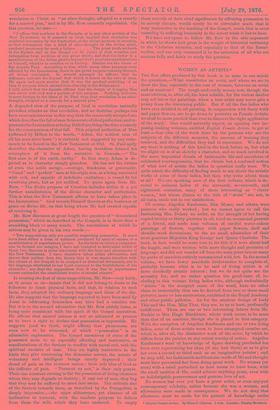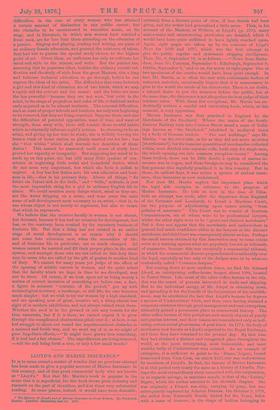WOMEN AS ARTISTS.*
TILE first effect produced by this book is to raise in our minds the questions,—What constitutes an artist, and where we are to draw the line, especially in the case of women, between an artist and an amateur? The rough-and-ready money teat, though the most obvious, is, after all, the least reliable, for the veriest dauber may sell his or her paintings, when a true artist may never gain a penny from the discerning public. But if all the fine ladies who have ever dabbled in oil painting, in conjunction with fancy work and paper flowers, are to go down to posterity as Female Artists, we shall be more puzzled than ever to discover the right application of the word ! One would naturally expect, on opening two im- posing-looking volumes, entitled English Female Artists, to get at least a clear idea of the work done by the persons who are the subjects of the different memoirs, the amount of training they received, and the difficulties they had to encounter. We do not say there is nothing of this kind in the book before us, but what we alight on is of so sketchy a character, and so much involved in the more important details of fashionable life and anecdotes of celebrated contemporaries, that we obtain but a confused notion of what sort of artists the ladies in question really were. We quite admit the difficulty of finding much to say about the artistic works of some of these ladies, but then why write about them at all? We are speaking now of the first volume, which is de- voted to eminent ladies of the sixteenth, seventeenth, and eighteenth centuries, many of them interesting as "clever women," but whose claims to the title of " artist " are not, in all cases, made out to our satisfaction.
Of course, Angelica Kaufmann, Mrs. Moser, and others, were painters who really worked ; but we cannot agree to call the fascinating Mrs. Delany an artist, on the strength of her having copied twenty or thirty pictures in oil, tried an occasional portrait of a friend, and made nine volumes of careful water-colour paintings of flowers, together with paper flowers, shell and chenille-work decorations, to the no small admiration of their most gracious Majesties King George and Queen Charlotte. The book, in fact, would be more true to its title if it were about half the length, and were written with more thought and precision of language, and did not wander off from the main point into so many by-paths of anecdote entirely unconnected with Art. In the second volume, we have fewer anecdotic irrelevancies to complain of, probably because what is to be said of living artists is of more decidedly artistic interest ; but we do not quite see the necessity for, and we rather question the good-taste of, in- cluding in this volume living ladies who, although undoubtedly "artists "in the accepted sense of the word, have no other claim to immortality than can be derived from two or three small pictures, more or less meritorious, exhibited in the Royal Academy and other public galleries. As for the amateur doings of Lady This and the Hon Miss That, they are, to us at least, profoundly indifferent. There are one or two interesting letters from Mr. Ruskin to Mrs. Hugh Blackburn, whose work seems to be more than that of an amateur, though she is placed in that category. With the exception of Angelica Kaufmann and one or two living ladies, none of these artists seem to have attempted creative art, which is, after all, the distinctive work of the artist, by which he differs from the painter, to any extent worthy of notice. Angelica Kaufmann's want of knowledge of figure drawing precluded her from ever representing her ideas (if she had them) so as to give her even a second or third rank as an imaginative painter ; and we may add, her fashionable and feminine mode of life and thought must have prevented her from doing great work. No woman (or man) with a mind perturbed as hers seems to have been, with the small vanities of life, could achieve anything great, even with an indefatigable perseverance and genuine love of art.
No woman has ever yet been a great artist, or even enjoyed contemporary celebrity, unless because she was a woman, and allowances were made in consequence. We do not deny that allowance must be made for the pursuit of knowledge under
* English Female Artists. By Ellen C. Clayton. 2 vols. London: Tinsley Brothers. difficulties, in the case of every woman who has attained a certain amount of distinction in any public career; but the obstacles to be encountered in executive music, on the stage, and in literature, in which arts women have reached a front rank, are far less than those attending on the education of a painter. Singing and playing, reading and writing, are parts of an ordinary female education, and granted the existence of talent, they had but to pursue the special study chosen to the highest point of art. Given ideas, an authoress has only to cultivate her mind and style to the utmost, and write. But the painter has, assuming that he possesses ideas, besides the ordinary mental cul- tivation and the study of style from the great Masters, also a long and toilsome technical education to go through, before he can express the ideas of the artist. The difficulties that come between a girl and this kind of education are of two kinds, which we may rJughly call the external and the moral ; and the latter are none the less powerful "because they are not seen," but exist in the mind, in the shape of prejudices and rules of life so habitual and so early acquired as to be almost instincts. The external difficulties, such as want of proper schools and teachers, are onlynow beginning to be removed, but they are being removed. Suppose these, and also the difficulties of parental opposition, want of time, and want of strength, done away with, there still remain those mental habits which involuntarily influence a girl's actions. In choosing to be an artist, and giving up her time to study, she is wilfully leaving the beaten track of home duties, so plainly marked out for her ; has she "that within" which shall warrant her desertion of those duties ? This cannot be answered until years of study have proved her capacity or incapacity. But supposing her mind to be made up on this point, she has still many little qualms of con- science at neglecting little social and household duties, which do not seem very important, but which she feels it selfish to neglect. A boy has few duties save his own education and busi- ness in life,—that is his primary duty. Above all things, "Es bildet em n Talent sich in der Stile," and "Stifle," solitude, is just the most impossible thing for a girl in ordinary English life to attain. We could mention many things which, small as they are, act like water dripping on a stone, and wear away the calm sense of self-development most necessary to an artist,—that is, to one whose object is not merely to represent, but also to create that which he represents.
We believe that the creative faculty in women is not absent, but dormant, because it has had no occasion for development, but has, on the contrary, been crushed by the necessary business of feminine life. But that a thing has not existed in an earlier stage of social development is no reason why it should not come into existence now, when the necessities of life, and of feminine life in particular, are so much changed. All women cannot be married and fill their proper place in the social system, and amongst those who are not called to this duty there may be some who are called by the gift of genius to another kind of duty. We cannot for many years yet judge of the effect of the opening of artistic careers to women, and we quite admit that the faculty which we hope in time to see developed, may not be there. Of course, if we look upon art as being merely a matter of correct imitation of something set before one, a face, a figure in accurate "costume of the period," got up with archwological accuracy, a landscape, or still life, the case becomes much simpler ; but we wish to try our women by a high standard, and are speaking now of great, creative art, a thing almost lost sight of in modern exhibitions, and not always valued when there. Whether the seed is in the ground or not may remain for the time uncertain, but if it is there, we cannot expect it to grow through the complicated obstructions piled over it ; at best, it can but struggle to shoot out round the supeancumbent obstacles in a maimed and feeble way, and we must say of it, as we might of poor Angelica's efforts,—"It might have grown into something, if it had had a fair chance." The impediments are being removed, —will the soil bring forth a tree, or only a few small weeds ?



































 Previous page
Previous page